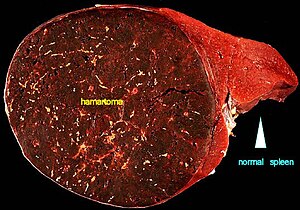Hamartoma
| Hamartoma | |
|---|---|
 |
|
| A large hamartoma of the spleen. The hamartoma is the dark circular object on the left that dominates the image. This is a cross-section; the growth is about 9 cm in diameter, while the entire spleen is about 11 cm in diameter. | |
| Classification and external resources | |
| Specialty | medical genetics |
| ICD-10 | Q85.9 |
| ICD-9-CM | 757.32, 759.6 |
| DiseasesDB | 19785 |
| Patient UK | Hamartoma |
| MeSH | D006222 |
A hamartoma is a mostly benign, focal malformation that resembles a neoplasm in the tissue of its origin. This is not a malignant tumor; it grows at the same rate as the surrounding tissue. It is composed of tissue elements normally found at that site, but they are growing in a disorganized manner. Hamartomas occur in many different parts of the body, and are most often asymptomatic incidentalomas (undetected until they are found incidentally on an imaging study obtained for another reason).
Additionally, the definition of hamartoma versus benign neoplasm is often unclear, since both lesions can be clonal. Lesions such as adenomas, developmental cysts, hemangiomas, lymphangiomas, and rhabdomyomas within the kidneys, lungs, or pancreas are interpreted by some experts as hamartomas while others consider them true neoplasms. Moreover, even though hamartomas show a benign histology, there is a risk of some rare but life-threatening clinical issues such as those found in neurofibromatosis type I and tuberous sclerosis.
Choristomas, forms of heterotopia, are closely related benign tumors, found in abnormal locations. The two can be differentiated as follows: a hamartoma is an excess of normal tissue in a normal situation (e.g., a birthmark on the skin), while a choristoma is an excess of tissue in an abnormal situation (e.g., pancreatic tissue in the duodenum).
Hamartomas result from an abnormal formation of normal tissue, although the underlying reasons for the abnormality are not fully understood. They grow along with, and at the same rate as, the organ from whose tissue they are made, and, unlike cancerous tumors, only rarely invade or compress surrounding structures significantly.
...
Wikipedia
